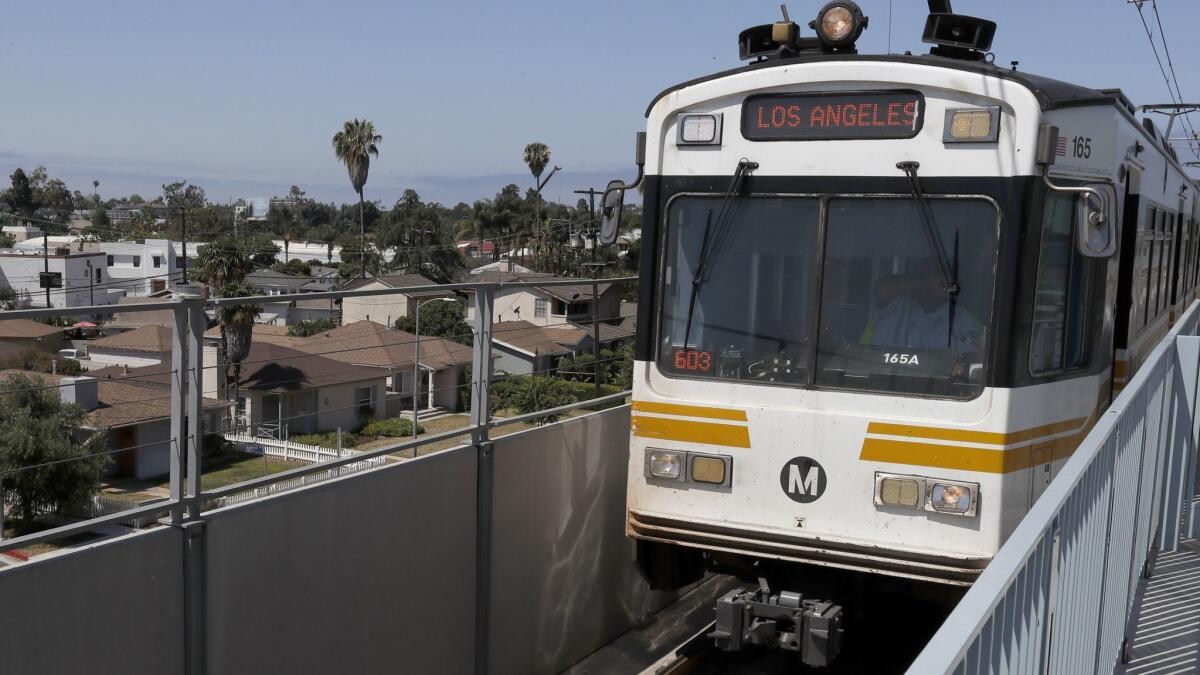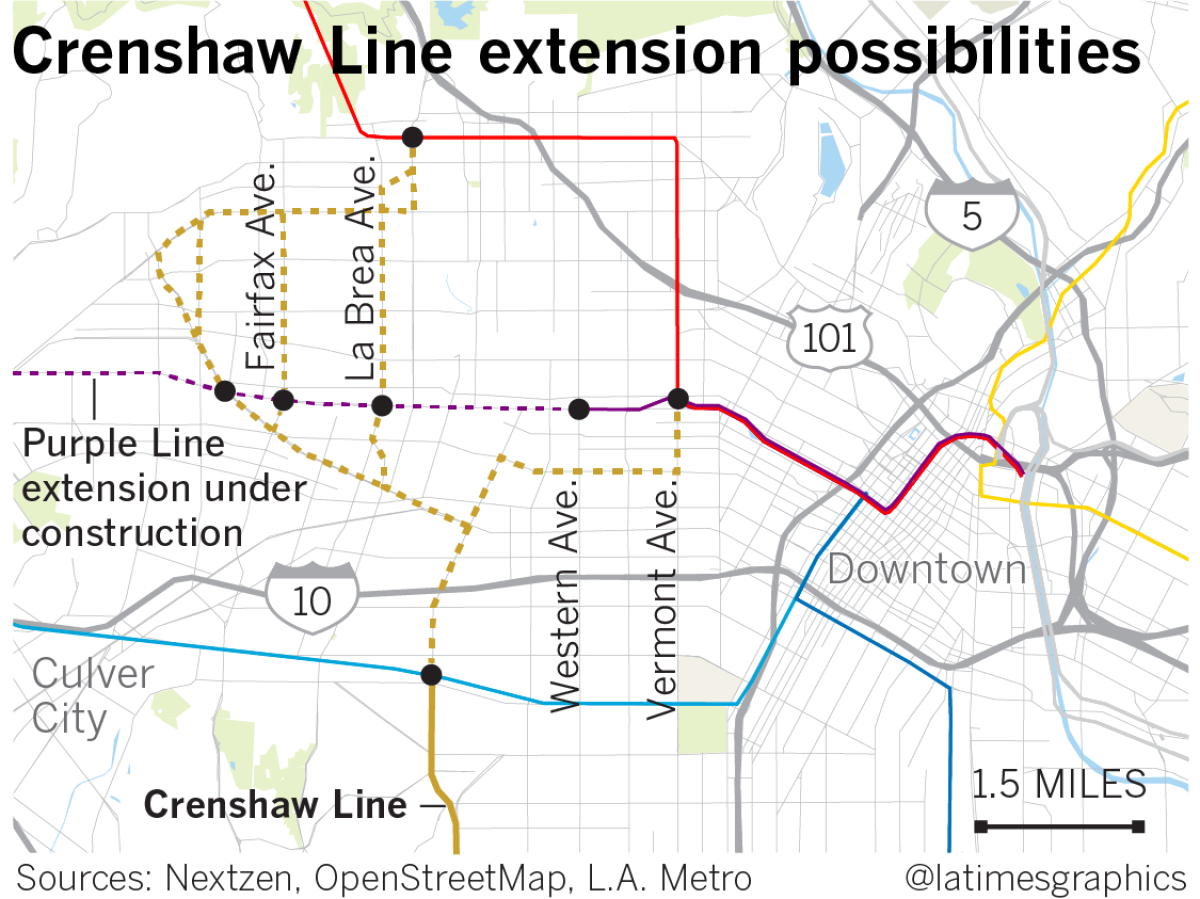Will it take until 2047 to extend the Metro to West Hollywood?

- Share via
The Metropolitan Transportation Authority’s passenger rail system stretches deep into the corners of Los Angeles County, drawing commuters to downtown from Long Beach, Azusa, North Hollywood and Santa Monica.
But only a handful of the Metro system’s 93 stations intersect with a second line, a design that often forces riders to travel miles out of the way to change trains.
A rail extension Metro is planning through Hollywood, Beverly Grove and West Hollywood would address that problem, serving as a north-south spine through central L.A. and creating transfer points with three other rail lines.
But the line is not slated to open for another three decades. Citing the line’s high ridership numbers, West Hollywood officials and transit advocates are pushing to speed the project’s construction, aiming instead for a ribbon-cutting before the 2028 Summer Olympics in Los Angeles.
“The project is so strong, and so compelling,” said Joanna Hankamer, a principal planner at the city of West Hollywood. “It’s filling a gap in the regional network.”

The route would be an extension of the 8.5-mile Crenshaw Line, which will run from Westchester to Baldwin Hills/Crenshaw when it opens late next year. The line would extend north from the Expo/Crenshaw station, terminating at the Hollywood/Highland subway station.
The area studied for the route — a crescent shape that includes West Hollywood, Mid-City, Miracle Mile and Arlington Heights — has a higher population density per square mile than San Francisco, Boston and Chicago.
Six of Metro’s 10 most popular bus lines cross through the area, the agency said. The agency said ridership on the extension could top 90,000 trips per day, which would make it the busiest light-rail line in the United States.
“It’s a good line in a dense part of town,” said David Mieger, a Metro executive officer for mobility corridor planning. “It could provide a very strong north-south connector through the central part of Los Angeles.”
Metro riders would be able to travel from Hollywood to Westchester without changing trains. From there, they could board a smaller airport circulator train, expected to open in 2023, to reach Los Angeles International Airport.
The route would also eliminate the need for San Fernando Valley and South Bay rail riders to transfer through downtown to reach Santa Monica, Koreatown or USC.
The line is slated to receive nearly $2 billion in funding through Measure M, the sales tax for transportation projects that county voters approved in 2016, in 2041. The extension’s estimated ribbon-cutting is in 2047.
Thirty years is too long to wait for a project that could have the highest ridership of any U.S. light-rail line, West Hollywood officials say. The city has lobbied for years for rail access, saying strong nightlife, high employment figures and the distance from any freeway makes the city a strong contender.
Under the proposal, the Crenshaw Line would be extended north from its current terminus at the Expo Line station on Crenshaw Boulevard, adding two stops in Jefferson Park and Arlington Heights.
There, the plans for the line diverge, with a route proposed parallel to most major north-south streets in the area.
One option would follow San Vicente Boulevard for 9.5 miles through Mid-Wilshire, Carthay, Beverly Grove and West Hollywood. The line would add nine stops to the Metro Rail network, including one near the Beverly Center and Cedars-Sinai, and would carry an estimated 90,800 daily trips.
A similar route option would run at street level and on aerial tracks along San Vicente, then curve onto La Cienega, where the tracks would be elevated. That 9.2-mile route would take 19 minutes and would carry a similar number of riders as the San Vicente route, Metro said.
A rail tunnel beneath Fairfax Avenue would be the most expensive, at an estimated $4.7 billion. Metro estimates the 8.1-mile route would carry 88,700 daily riders through Mid-Wilshire, Fairfax and West Hollywood, and would stop near the Grove, the Original Farmers Market and the La Brea Tar Pits.
The $3-billion, 6.5-mile route along La Brea Avenue is the most direct path between the Expo Line and Red Line stations. The line would have six stops, and would run on elevated tracks between San Vicente and Fountain Avenue.
The Vermont Avenue route is the only option that would not run through Beverly Grove and West Hollywood. Instead, the $3.6-billion route would run underground for 10.2 miles between Baldwin Hills and Koreatown, with stations in Arlington Heights and Harvard Heights.
The price tag for the route runs from $3 billion to $4.7 billion. The biggest known variable is Metro’s choice to build the line at street level, above ground or as a subway.
Building at street level is the cheapest option, at about $150 million per mile, but it can create operational problems. The traffic congestion at many of the major intersections in the study area is too severe to accommodate a train at street level, Mieger said.
Metro’s Blue Line, which runs at street level along much of its route, has one of the highest fatality rates of any U.S. light-rail line. Commuters frequently face delays when trains strike vehicles or pedestrians on the tracks.
An aerial line along a major boulevard or avenue, similar to Chicago’s L, would cost about twice as much per mile, but would not face the same conflicts with drivers and traffic lights.
Tunneling and excavating stations for underground lines are far more costly, pushing the price tag for subway construction to at least $700 million per mile, Metro said.
Metro requires that cities cover 3% of the costs for any portion of a major transit project build within the city limits. Depending on the route selected, West Hollywood would be asked to provide $42 million to $66 million, officials said.
A new policy at Metro also allows cities and other groups to attempt to accelerate construction for projects, if they can secure 5% to 25% of the project’s total cost. Depending on the route Metro selects, that could be at least $550 million.
West Hollywood agreed in May to hire a consultant to locate other sources of funding, including raising the city’s sales tax, bonding against the local sales tax revenue from Measure M, or securing a partnership with a company that could pay for part of the construction.
The line’s high ridership estimates make it a strong contender for a federal funding match of up to 50% of the total cost, Hankamer said.
“I think we’ll have to see how that develops,” Mieger said. The line is still in the early planning stages, he said, and several other communities slated to receive a major Metro line are also looking to accelerate their projects.
Metro will begin public outreach for the line this fall in Los Angeles and in West Hollywood. Officials there know, Mieger said, that “the Westside is never shy about telling us what they think.”
Twitter: @laura_nelson
More to Read
Sign up for Essential California
The most important California stories and recommendations in your inbox every morning.
You may occasionally receive promotional content from the Los Angeles Times.











